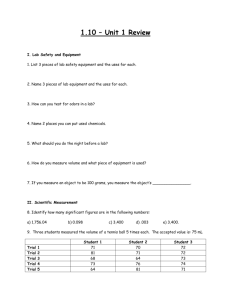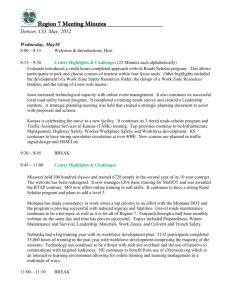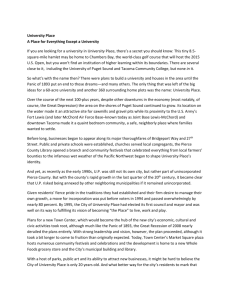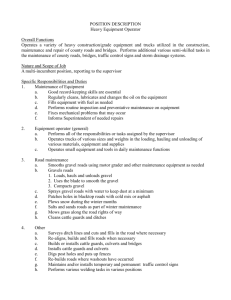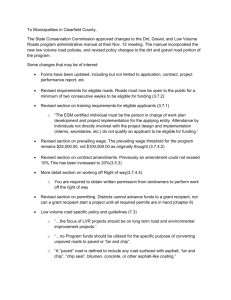Making informed decisions on when to upgrade a gravel road October 2006
advertisement
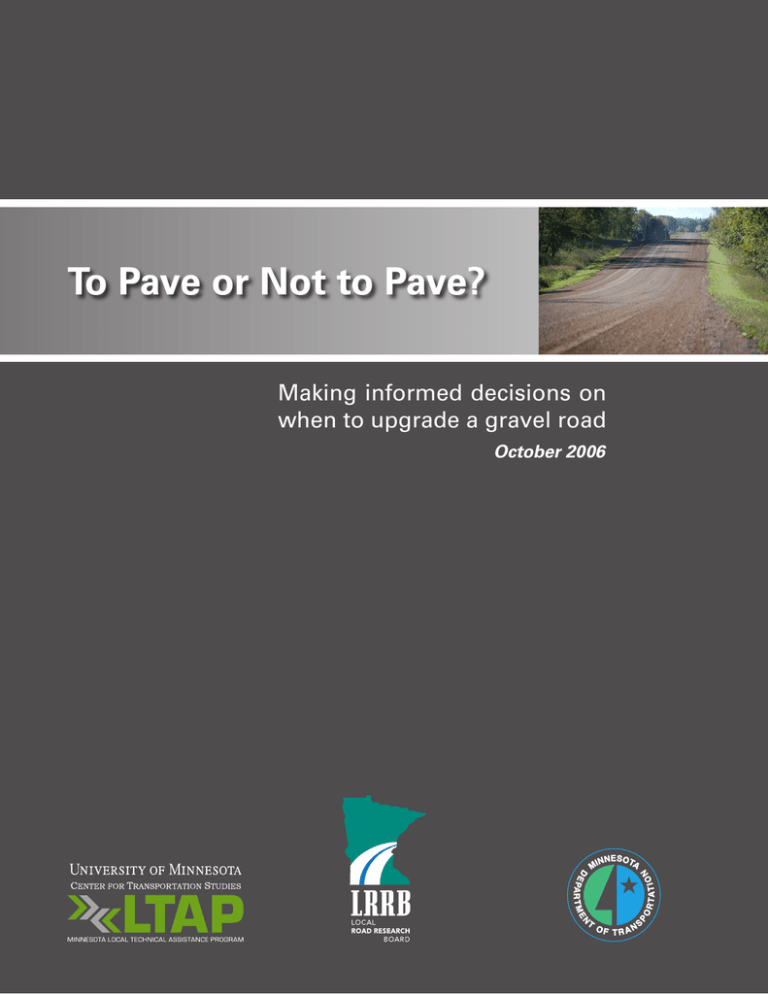
Making informed decisions on when to upgrade a gravel road October 2006 Introduction Paved roads provide improvement over gravel in ways that are hard to quantify with dollars, including improved winter surfaces, improved safety from improved signage and delineation, a safer surface with higher skid resistance, a smoother surface that increases user satisfaction and reduces vehicle maintenance costs, redistribution of traffic away from gravel roads, and an increased tax base on adjacent property. Of the estimated 4 million miles of roads in the United States, nearly half—1.5 million miles—are unpaved. Unpaved roads serve a valued purpose in our roadway system, but maintenance costs are significant. Paved roadways also are costly to maintain. Like everything else, maintenance costs for both paved and unpaved roads are rising. We need to optimize those costs to best serve the public. Reduced funding and resources require us to be more efficient spenders of the money we do have. Preparing for future maintenance and upgrades allows us to better manage funds that are available now. How do we know when it’s time to pave a gravel road? The decision is not easy. Two newly published research reports provide some direction and assistance in answering this question. The projects outlined in the reports had different objectives, but both of them offer a method of cost-analysis based on spending history for low-volume roads, a method for estimating maintenance and construction costs, and an economic analysis procedure. The first report is Economics of Upgrading an Aggregrate Road. This report, published in 2005, was funded by the Minnesota Local Road Research Board (LRRB). As part of this project, researchers examined roadway surface construction and maintenance costs to determine possible threshold values to go from gravel to paved. The report is available online at: www.mnltap.umn.edu/resources/infrastructure/lowvolume. html. The second report is Local Road Surfacing Criteria. This report, published in 2004, was funded by the South Dakota DOT. In this project, researchers developed a tool to compare the costs associated with different types of roads to determine the most economical surface type. This report is available online at: www.mnltap.umn.edu/resources/infrastructure /lowvolume.html. To supplement the research reports, LRRB developed a PowerPoint presentation for use at local board or public information meetings. Its prime objective is to inform the public about the many factors to consider when developing a plan to maintain or upgrade a gravel road. The presentation outlines information that engineers and public works staff consider when deciding whether to pave a gravel surface. Two versions of the LRRB paving PowerPoint presentation are available. One is designed to run on its own, with narration and an automatic slide show. The other is designed as a traditional PowerPoint presentation, with the user verbalizing the slide content and advancing the slides as needed. It includes a script for the user to read during the presentation, if desired. The Issue Two key questions must be answered when developing a gravel road maintenance plan: 1. What is the best way to maintain a gravel road? 2. When should the roadway be upgraded to a paved surface? These are not easy questions because many factors affect the answers. As noted above, the following two recent reports can be used to help decide when to upgrade a gravel road. Using Minnesota’s report: Economics of Upgrading an Aggregrate Road This project, conducted in Minnesota, offers an analysis of county maintenance costs, practices, and traffic volumes for individual roads. This information helps to determine when it may be advantageous to upgrade the road, based on cumulative maintenance costs. The data presented in the report can be used by others, or they can develop similar costs with their own data. For this project, the initial data collection included 16 Minnesota counties, broken into four regions around the state. It includes maintenance costs for both bituminous (or asphalt) and gravel roads, as well as the volume of traffic traveling over the roads. Baseline data was obtained from annual reports submitted to the State Aid Division of Mn/DOT from 1997 to 2001, and roads were grouped by funding source as County State Aid Highways (CSAH), county roads (funded entirely by county funds), and township and municipal roads. Four of the counties were then analyzed further to develop typical costs per mile for a variety of surface options, including gravel and paved. Researchers conducted an initial data analysis for Waseca County, which provided a snapshot of the kind of information available for use in this study. Figure 1 shows actual maintenance costs per mile in Waseca County for five different roadway surfaces: • Low-volume bituminous roads • Low-volume gravel roads • Concrete pavement • High-volume bituminous roads • High-volume gravel roads. Note that maintenance costs per mile for high-volume gravel roads are highest. This brochure and the materials it references are available online from Minnesota LTAP at: www.mnltap.umn.edu/resources/infrastructure/lowvolume.html Figure 2 illustrates the effect of traffic on maintenance costs per mile for one county. The roads are grouped by traffic volume and surface type along the bottom of the graph. An increase in traffic does lead to an increase in maintenance costs, especially for gravel roads. This is due to more lost gravel due to wear, and an increased need for blading and smoothing of the road surface. Note that at a traffic volume of 200 ADT, gravel road maintenance costs increase significantly. (ADT stands for average daily traffic, or the number of vehicles that pass over a given section of roadway in one day.) This offers a possible threshold for determining when this agency might pave a gravel road. Using this report in your agency The Minnesota report can be used to assist local agencies in estimating their own maintenance costs per mile. Agencies can use that data to decide if paving a gravel road is the best alternative. The report directs users to: 1. Review the historical costs of maintaining paved roads for your agency. (If those costs are not available, review data for one of the four counties analyzed in the report to get an idea of what your costs might be.) 2. Compute estimated gravel road maintenance costs per mile for your agency. 3. For a proposed upgrade, develop a cost estimate in the same way a contractor would for any new construction project under consideration. 4. Evaluate this cost estimate to compare the alternatives and make a decision for each roadway segment under question. By using the information presented in this report, an agency can evaluate its typical maintenance and construction costs, as well as identify the annual maintenance costs for a given type of roadway (whether it’s paved or unpaved), and the typical construction costs for a variety of surface projects. Directions are also given for performing a present-worth analysis to assess maintenance and construction costs for a roadway section to see what the equivalent maintenance and construction costs are in today’s dollars. $80,000 $70,000 $60,000 $50,000 $40,000 $30,000 $20,000 $10,000 $1984 1986 1988 1990 1992 1994 1996 1998 2000 2002 Time (years) Low Volume Bituminous Low Volume Gravel High Volume Bituminous High Volume Gravel Concrete Figure 1. Cumulative Maintenance Costs/Mile for One County $3,000 $2,500 $2,000 $1,500 $1,000 $500 $0 ADT RANGE BITUMINOUS GRAVEL Figure 2. Maintenance Costs/Mile at Various Traffic Levels for One County Using South Dakota’s report: Local Road Surfacing Criteria The second tool was completed as part of a project that investigated several surfacing criteria for low-volume roads. The main objective of this project was to create a process comparing maintenance requirements for different surface types to assist in selecting the most economical alternative under a given set of conditions. Surface types include hot-mix asphalt, blotter, gravel, and stabilized gravel roads. Many of the project elements are similar to the Minnesota project. However, the South Dakota project developed an easyto-use computerized tool that allows agencies to input local costs and treatments to fit their own conditions. This computerized tool leads the user through a series of steps to: 1. Input information about the road section, including the project limits and the average daily traffic (ADT) count. 2. Input the actual agency maintenance and construction costs, broken down by surface type. 3. Estimate user costs, which are costs to the people that drive on the roads, and include vehicle operating and crash costs associated with a roadway surface type. These user costs can even be weighted to give them more or less importance in the analysis. After all the initial input variables are submitted, the computer program summarizes total costs for building and maintaining each roadway type. The evaluator then inputs other non-economic factors that relate to all surface types, including growth rates for an area, housing concentration and dust control needs, mail route locations, truck traffic, and political considerations. Again, the evaluator is allowed to weight each of the factors in the analysis. This tool provides output that is both easy to generate and understand. Cost comparisons can be computed for several alternatives. In addition, the user is assisted in selecting appropriate input variables for a typical agency. The results are objective and assist in making a clear comparison for a variety of roadway surface types. Accessing and using the computerized tool This tool is available online at: www.mnltap.umn.edu/ resources/infrastructure /lowvolume.html. Useful information regarding this report can be downloaded in three forms: •F ull Report— the complete report, with references, data and research process fully outlined. •U ser’s Guide—a hands-on guide that introduces the macro-driven, Excel-based analytical tool developed to apply the low-volume road management methodologies recommended under the project. •T echnical Brief—developed to provide a step-by-step procedure for making road-surface type decisions between different surface materials (hot-mix asphalt [HMA], blotter, gravel, and stabilized gravel) on low-volume roadways. The methodology presented in this Technical Brief provides a practical tool to assist agencies with decisions about the most cost-effective road surface type to be used in various situations. The User’s Guide will outline all steps required to download the software and populate the required fields with local data. It is a comprehensive guide to understanding every input variable available for the analysis. Using this report in your agency With this tool, the user can input actual local costs for maintenance and construction activities. The user also can supplement those costs with road-user costs (such as crash data and qualityof-life considerations), as well as other non-economic factors. The computer program then provides actual ratings for each surface type based on the different input variables. The user can then select one surfacing alternative over another, based on these ratings and local priorities. Summary The results of both gravel road studies note that maintenance and construction costs vary considerably from one agency to another, and from one season to another. Traffic is a primary factor in deciding to pave or not to pave. The Minnesota study found that gravel road maintenance costs per mile appear to increase considerably after an ADT level of 200 vehicles/day. On the other hand, the South Dakota study found that paved roads are most cost-effective at ADT levels above 150 vehicles/day. So, decisions can be made based on traffic data, local construction and maintenance costs, and area growth values to determine if and when a roadway should be paved. Information from both reports can be used to make informed decisions about paving a gravel road, or maintaining it as a gravel surface. Thanks to the findings of both projects, we are better prepared to move forward in developing an efficient and appropriate maintenance and construction strategy. Finally, the presentation developed by LRRB can assist local highway staff in making the public aware of the many factors affecting the decision. Acknowledgements We appreciate the assistance of the following people who served on the Technical Advisory Panel for this project: Dave Fricke, Minnesota Association of Townships Eddie Johnson, Mn/DOT Mike Sheehan, Olmsted County Roger Olson, Mn/DOT Kathy Schaefer, Mn/DOT and Minnesota LTAP/CTAP Paul Stine, Mn/DOT Jim Grothaus, Minnesota LTAP


